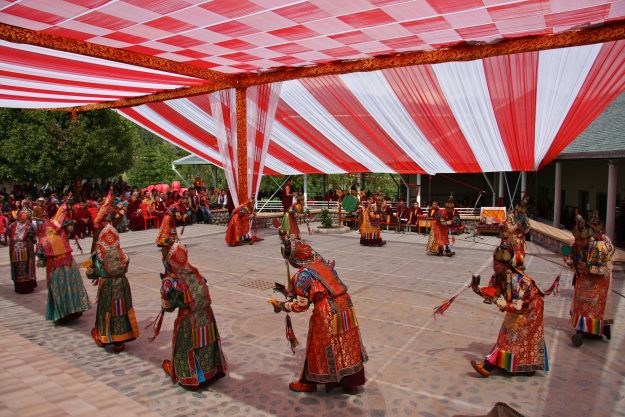Embodying Enlightenment
Exploring the sacred ritual dances of Vajrayana Buddhism The post Embodying Enlightenment appeared first on Tricycle: The Buddhist Review.

Vajrayana practitioners often engage in dance as an embodied form of Buddhist practice. Across the Himalayan region, Tibetan Buddhist monastics and lay practitioners observe a calendar of somatic rites, including sacred dances called cham. Some are performed in private spaces, while others are the focal point of communal gatherings in monasteries, nunneries, and temples. In the Newar tradition of Nepal, dance is also a key element of spiritual practice and devotional ritual. Each culture has its own costumes, styles, and traditions, but the entire Vajrayana world is suffused with dance.
Vajrayana Buddhism takes its name from the Sanskrit word vajra, which means “diamond” or “thunderbolt”—signifying an indestructible, radical power to achieve awakening—and yana, the word for path. The tradition brings a variety of ritual technologies onto the path: visualization practices, mantra recitation, instrumental music, prayer, mudras, yogic exercises, and sacred dance. Practitioners use these techniques to transform their body, speech, and mind into those of an awakened being—i.e., a buddha.
 Ratna Kaji Vajracharya (1934-1999) teaching a young student the mudra for Green Tara | Courtesy of Prajwal Ratna Vajracharya
Ratna Kaji Vajracharya (1934-1999) teaching a young student the mudra for Green Tara | Courtesy of Prajwal Ratna VajracharyaIn the Tibetan Buddhist world, cham often replicates the dances and methods attributed to Padmasambhava, the master credited with bringing Buddhism to Tibet and Bhutan in the 8th century. Cham dances are performed publicly as part of large-scale festivals that last from one to five days. The ritualistic movements vary widely according to region and lineage, often including a large cast of masked dancers who are costumed in brocade robes, ornaments, and boots. Participants manipulate ritual implements in their hands (like a bell and vajra) while dancing. In some traditions, monks and nuns regularly perform dances to songs of realization (Tib.: gurma) composed by their lineage masters. The Bhutanese have a unique lay cham tradition performed as an integral part of their festivals.
In the Newar tradition of Nepal, Vajracharya priests in the Kathmandu Valley perform the charya nritya (“dance as a spiritual discipline”) as an embodied support for deity yoga. The practice incorporates the choreography and bodily gestures specific to traditional deities—such as Tara, Avalokiteshvara, Vajrayogini, and the Five Buddhas, among many others—together with their colorful costumes and symbolic ornaments. Performed along with the charya giti (sung praises and descriptions of the deities), the dances resemble a living animation of a deity painting.
Like meditation, all forms of dance demand presence in the here and now. The dancer must maintain a relational awareness to many things at once:
the body itself: engaging in constant awareness of the dance movements, making present-moment decisions about modulating energy, force, momentum, and direction the surrounding space the spatial patterns of the dance itself time—as defined by the accompaniment: instrumental music, drum or cymbal percussion, or sung liturgy the other dancersVajrayana dance is similar to other forms of dance in these ways, but it also calls for markedly specific types of intention, visualization, chanting, and ritualistic movement.
 A great Tibetan spiritual master dances: Khyentse Chökyi Lodrö (1893-1959) | Courtesy of Shechen Monastery Archives
A great Tibetan spiritual master dances: Khyentse Chökyi Lodrö (1893-1959) | Courtesy of Shechen Monastery ArchivesVajrayana dance is done with the intention to transform and liberate oneself and all beings. Even before taking a single step, the dancer contemplates “I am performing this sacred expression to transform myself and all beings into our awakened nature”: an awareness that we are all interconnected in a display of compassion and transcendent qualities. Vajrayana dancers also visualize themselves alongside celestial dancers that add to the spiritual effort; and at the end of the dance, they mentally dedicate the merit (positive energy) for the benefit of all beings.
Deity yoga is a fundamental Vajrayana technique in which practitioners visualize themselves as an enlightened being, or deity, with all its attributes of wisdom and virtue. Sacred dance is a support for this practice in both the Newar and Tibetan traditions. In Nepal, these dances were traditionally done only by non-monastic Vajracharya priests, but today they are performed by anyone initiated into the teachings.
 Prajwal Ratna Vajracharya dancing Avalokiteshvara | Courtesy of Prajwal Ratna Vajracharya
Prajwal Ratna Vajracharya dancing Avalokiteshvara | Courtesy of Prajwal Ratna VajracharyaPrajwal Ratna Vajracharya, a 35th generation Newar Vajrayana priest and practitioner of charya nritya, expounds on the benefits of dance by quoting the Hevajra Tantra (late 8th century): “The yogi must always sing and dance.” Prajwal emphasizes the importance of dance in his Newar tradition, declaring that “Without singing and dancing, there can be no enlightenment.” Prajwal also notes that every Newar Vajrayana deity practice (Skt.: sadhana) has a dance component.
Vajrayana dance is a way of displaying a sacred realm with body, speech, and mind. The dancers create a mandala with the body through movement, with speech through the recitation of liturgies and mantra, and with the mind through intention and visualization. The dances contain similar iconographic elements to those in a painted mandala, but in this form they are animated, living and breathing, three-dimensional mandalas.
In Vajrayana thought, the physical body is also considered a sacred mandala—a microcosm of the greater universe. Dance is understood to affect the “subtle body,” an energetic structure that can be awakened through breathing, movement, and visualization practices.
Vajrayana dancers create a mandala with the body through movement, with speech through the recitation of liturgies and mantra, and with the mind through intention and visualization.
The Nyingma master Thinley Norbu Rinpoche (1931–2011) gave detailed explanations on the impact of dance on the subtle body: “The temporary benefit of dharma dance is to untie knots in the karmic chakras, so the nerves and channels of the body are disentangled, and the airs of vital energy are cleansed to flow smoothly. . . . The body’s energy becomes very light. . . .”
Dzogchen master Chögyal Namkhai Norbu Rinpoche (1938–2018) dedicated much of his efforts to transmitting a series of Vajra Dances, as a means to harmonize body, energy, and mind. He emphasized the value of dance for stabilizing contemplative practice.
 Guru Padmasambhava in Dancing Posture (Thangka section)
Guru Padmasambhava in Dancing Posture (Thangka section)Numerous dance traditions emulate Padmasambhava’s initial display of cham. A passage in one of his biographies describes the ground consecration for the first monastery in Tibet:
Padmasambhava donned ornaments of jewelry and bone, took a vajra and bell in his hands and, uttering HUNG, flew up into the sky, where he performed the consecration of the land with a vajra dance. The local spirits helped lay the foundation by placing stones on the lines where his shadow fell.
This consecration ritual, which includes dance, serves as the origin story and prototype for many of the cham still performed today, particularly in the Nyingma school of Tibetan Buddhism.
In some Tibetan Buddhist Drukpa Kagyu monasteries, gurma dances are performed on a variety of occasions: as a ritualized offering during certain prayer ceremonies; during special teachings; upon the completion of long retreats, the consecration of temples, and stupas; and to mark the birth and death anniversaries of lineage masters. Lopön Jigme Tingdzin Zangmo, cham master and head teacher of philosophy for the Drukpa Kung fu nuns, shared this about their gurma dance practice:
When the Drukpa masters attained realization, they spontaneously erupted in joyous songs of realization (gurma) and dance. Their close disciples wrote these songs down. We perform Vajrayana dances to these gurma in the tradition of our great lineage masters hoping that we too will swiftly realize the ultimate nature.
 Tashi Cham—Drukpa Nuns perform a Gurma of Auspiciousness | Photo Courtesy of the Drukpa Nuns
Tashi Cham—Drukpa Nuns perform a Gurma of Auspiciousness | Photo Courtesy of the Drukpa NunsThese dances often involve moving together in a circle, with simple steps (hops, kicks, turns) and expressive hand gestures. They are performed in monastic robes to melodious songs, sung by the monks or nuns themselves as they dance, without any instrumental accompaniment. The lyrics speak to the joys of the spiritual path—for one’s guru, for the teachings and practices, and for all sources of spiritual support and refuge. The dances and accompanying melodies also evoke energy, benevolence, and veneration. Gurma is considered capable of liberating through hearing.
After dancing in front of a large gathering in Bodhgaya, India, H.H. the 17th Karmapa explained the benefits of viewing cham in a public talk. Great Vajrayana masters have long insisted that cham is a type of “liberation upon seeing” (Tib.: thongdrol), igniting a transformation in the performer and the observer alike.
*
Vajrayana Dance is also done as a component of other rituals. Examples include:
In Vajrayana offering prayers, practitioners generally chant while using hand gestures that represent and magnify each sense offering: water, flowers, incense, butter lamps, perfume, food, and music. In both the Newar and Tibetan traditions, sixteen sense offerings are frequently presented through a dance of sixteen offering goddesses. The representational gestures and dances enrich and deepen the gravitas of the moment. As Thinley Norbu Rinpoche explained, “In the precious Vajrayana tradition, in which the offering of dance is practiced, everything is turned into virtue, including all movement.”
 Rigma Chudruk Cham (Dance of the Sixteen Offering Goddesses) | Photo Courtesy of Dongyu Gatsal Ling Nunnery
Rigma Chudruk Cham (Dance of the Sixteen Offering Goddesses) | Photo Courtesy of Dongyu Gatsal Ling NunneryVajrayana dance is also used to increase the auspiciousness of events, whether to welcome a lama or invoke the deity’s presence during a ritual. The Drukpa nuns and monks frequently conclude large ceremonial events with a gurma dance called “Tashi Cham” to offer auspicious wishes. The dancers move in a circle, holding a set of five-colored streamers (that represent the five natural elements and five wisdoms) in each hand, tossing their arms up and around in spirals, stirring up a joy that reflects the sung lyrics of good fortune.
Cham is also done to expedite and amplify ritual activity. For example, it is common to perform the Dance of Five Dakinis (Tib.: Khandro Denga Cham) during the long-life (tenzhug) prayer. The dancers offer ritual cakes, entreating the dakinis to extend the life of the lama. In the week leading up to the Tibetan New Year (Losar), Vajrakilaya rituals coalesce fierce energy to subjugate and remove obstacles (both internal and external) and purify the spiritual environment for a fresh start to the year. Vajrayana dances are done to expedite this intense activity. Across cham traditions, specific instruments and vocal accompaniments, visually striking costumes and masks, and set choreographies capture the attention of beings in the human (and animal) realm—as well as those in the celestial realms—adding to the potency of the associated ritual.
 Tum Ngam Cham (Dance of the terrifying Deities) performed at Ralang Monastery in Sikkim | Photo by Karen Greenspan
Tum Ngam Cham (Dance of the terrifying Deities) performed at Ralang Monastery in Sikkim | Photo by Karen GreenspanFierce Vajrayana rituals and the associated subjugating and obstacle-removing dances have at times been applied in pacifying or killing enemies, and in military defense. Following the legendary activities of Padmasambhava, sorcery has been used to “protect the doctrine” and preserve the geopolitical integrity of both Tibet and Bhutan. To this day, the Dance of the Eight Classes of Spirits (Degyed Cham) and the Dance of Mahakali (Lham Tsom Cham) are performed to honor Mahakala, the steadfast protector deity of the Bhutanese state. Private cham rituals are also performed in the protector deities’ chapel (goenkhang) of the Central Monastic Body’s monasteries.
 A costumed ritual dancer in Ladakh, India | Image courtesy of BJ Graf
A costumed ritual dancer in Ladakh, India | Image courtesy of BJ GrafIn the Himalayan lands, Vajrayana dances have historically been used to help transmit Buddhist teachings and traditional values. The Eight Manifestations of the Guru (Guru Tshengye) is a popular masked spectacle performed in many Himalayan Buddhist communities that conveys the accomplishments of Padmasambhava. Another example is the Dance of the Intermediate State (Bardo Cham)—a Bhutanese masked dance drama that teaches about karma and how to approach death. The cham, danced as a courtroom trial and embellished with humorous antics, is always a crowd-pleaser.
In Bhutan, dance is part of every aspect of life—the religious, national, and regional identity; social custom; fun and games; civic duty; and more. In addition to the monastic cham, the Bhutanese have a unique lay cham tradition performed with bare feet and costumed in lightweight yellow skirts with iconographic ornamentation, masks, and handheld implements; these dances include athletic squats, leaps, and jumps. Everyone dances—the monks, the schoolchildren, learned khenpos, great lamas, farmers, government officials, office workers, and even the king! And so, with Buddhist and traditional folk dances, the Bhutanese enhance their religious gatherings and festivals with heaps upon heaps of dance offerings. Today, even Bollywood imitations are included in dance offerings.
*
For many, the idea of enlightenment may feel abstract and well beyond their reach. Yet, across numerous cultures, Vajrayana dancers perform enlightenment, moving in ways that cut through delusion and obstacles and evoke compassion and wisdom. The dances are a form of heroic spiritual practice, the movements producing energy that brings everyone along on the journey to liberation. And with practice comes ingrained, innate behavior. Vajrayana masters don’t just teach this—they embody it. They know because they dance.

 Aliver
Aliver 























.jpg)







